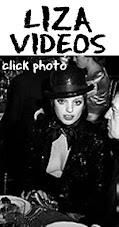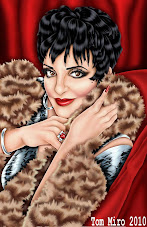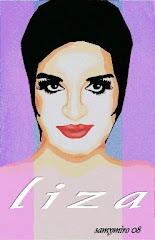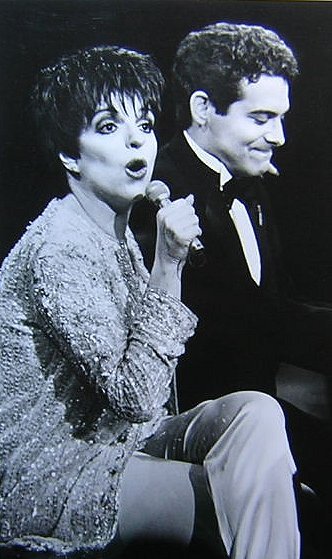
'If artistically you are able to do one thing," Kay Thompson said in a 1957 interview, "you are more than likely able to do them all." It was a distinctly curious observation, borne out by few -- apart from the speaker herself. Thompson, whose life and music are being celebrated by her goddaughter Liza Minnelli in her show at the Palace Theatre, is best known to posterity as the creator of the series of children's books starring Eloise, one of the major literary characters of the baby boom. But for much of her long life, which stretched from 1909 to 1998, Thompson was active as a vocalist, vocal arranger, choir leader, composer, lyricist, actress and comedienne.
At the Palace, Ms. Minnelli describes her godmother as "a life force" and "a true Renaissance woman." Ms. Minnelli's connection to Thompson runs deep: Thompson first began working with Ms. Minnelli's mother, Judy Garland, on the radio in the late 1930s. She frequently scored the vocal parts for Garland in the classic movie musicals of the 1940s and played a large part in the success of such Garland standards as "On the Atchison, Topeka, and the Sante Fe."
Thompson and Garland were also best friends; Ms. Minnelli speaks of how, when she made her stage debut at age 13, Garland and Thompson both wept uncontrollably when Ms. Minnelli did her 22-second solo dance. When Garland died nine years later, Thompson was the first friend at Ms. Minnelli's side. Michael Feinstein, who co-produced Ms. Minnelli's new album, told me that her current show "is the most personal of all because of her tribute to Kay. Perhaps it's odd at first glance to think that it's more personal than a tribute to her mother or father might be. But Kay's work envelops her parents' legacy and also encapsulates the many years that Liza spent with Kay in her formative years."
Apart from her successes as a vocal arranger and author (and a fashion designer and interior decorator), Thompson enjoyed an intermittent career as a performer, most famously in one of the last great Hollywood musicals, the 1957 "Funny Face." But "I always thought, when I was little, that I was ugly," she said in 1937; this was hardly the self-image one needs for a singing career. Born and raised in Missouri, she later said "I was a stage-struck kid and I got out of St. Louis fast." At age 19, Thompson arrived in Hollywood but learned the hard way that she didn't have the looks to get work in the movies -- even as a comic.
Within a few years, however, Thompson was a major presence on the radio, singing initially on a show starring the famous Mills Brothers -- the first of many vocal groups she would be associated with. She recorded in the mid-1930s, as a soloist (backed up, on one session, by her first husband, trombonist Jack Jenney); a "canary" (as they were referred to) with several different dance bands; and as leader and principal singer with vocal groups both male and female. (Most of her surviving recordings from this period are on "The Queen of Swing Vocal," a 2002 CD on Baldwin Street Music.)
In 1942, both Thompson and an early member of her ensemble, singer and composer Hugh Martin, joined the dream team assembled by producer Arthur Freed for such classics as "Meet Me in St. Louis" and "The Harvey Girls." However, she was restless to face the footlights again. She told Time magazine in 1947 that she would audition a chart for Freed and he would respond, "Kay, you sang that great, you are terrific. Now -- who will we get to sing it?"
In the summer of 1946, Thompson had time on her hands while waiting for a divorce in Reno, and she used it to write a nightclub act. A few months later she opened at Ciro's in Hollywood, backed by The Williams Brothers vocal quartet (including future superstar Andy Williams), and was an instant sensation. As she described it in Time: "We're five very virile people. Everything we do is to the hilt. If it's a chord, it's the most beautiful chord. If it's a dance, it's the most exciting dance. It's dizzy-making -- loaded with personality. It's rhythm, energy, humor, vitality, and sex, all wangled into one." Apart from her looks, Thompson did not lack for self-esteem, but the press agreed. Walter Winchell called it "the greatest act in history."
The centerpiece of "Liza's at the Palace" (which runs at least through Dec. 28) is a segment of six Thompson specialties, in which Ms. Minnelli is accompanied by a male quartet that includes Birdland regulars Jim Caruso and Johnny Rodgers, along with her longtime accompanists drummer Mike Berkowitz and pianist Billy Stritch. Using standards ("Basin Street Blues"; "Clap Yo' Hands," which Thompson later sang with Fred Astaire in "Funny Face") as well as Thompson originals ("Violin") as starting points, Thompson created (and Ms. Minnelli recreates) full-scale production numbers that not only add elaborate introductions and frames to the songs but recompose them, much the way an instrumental jazz arranger would. Indeed, a fast, swinging beat and the jazz-inspired concept of extreme interpretation animate much of Thompson's writings, particularly on a gospel-driven original like "Jubilee Time." The pieces require so much energy that even the tireless Ms. Minnelli is frequently left gasping for breath.
Thompson's arrangements show that Broadway and Swing Street could intersect in ways beyond geography. Unfortunately, she kept the act on the road only until 1953, during which time it was never sufficiently documented on recordings or film. She went back to work in Hollywood and eventually on "Eloise," and lived to be almost 90; 2009 marks the start of her centennial. As recounted in the Palace show, Kay Thompson summarized her life as "A lot of luck, a lot of joy, and a whole lot of tra-la-la."
Mr. Friedwald is the author of seven books on music and popular culture.
Thompson and Garland were also best friends; Ms. Minnelli speaks of how, when she made her stage debut at age 13, Garland and Thompson both wept uncontrollably when Ms. Minnelli did her 22-second solo dance. When Garland died nine years later, Thompson was the first friend at Ms. Minnelli's side. Michael Feinstein, who co-produced Ms. Minnelli's new album, told me that her current show "is the most personal of all because of her tribute to Kay. Perhaps it's odd at first glance to think that it's more personal than a tribute to her mother or father might be. But Kay's work envelops her parents' legacy and also encapsulates the many years that Liza spent with Kay in her formative years."
Apart from her successes as a vocal arranger and author (and a fashion designer and interior decorator), Thompson enjoyed an intermittent career as a performer, most famously in one of the last great Hollywood musicals, the 1957 "Funny Face." But "I always thought, when I was little, that I was ugly," she said in 1937; this was hardly the self-image one needs for a singing career. Born and raised in Missouri, she later said "I was a stage-struck kid and I got out of St. Louis fast." At age 19, Thompson arrived in Hollywood but learned the hard way that she didn't have the looks to get work in the movies -- even as a comic.
Within a few years, however, Thompson was a major presence on the radio, singing initially on a show starring the famous Mills Brothers -- the first of many vocal groups she would be associated with. She recorded in the mid-1930s, as a soloist (backed up, on one session, by her first husband, trombonist Jack Jenney); a "canary" (as they were referred to) with several different dance bands; and as leader and principal singer with vocal groups both male and female. (Most of her surviving recordings from this period are on "The Queen of Swing Vocal," a 2002 CD on Baldwin Street Music.)
In 1942, both Thompson and an early member of her ensemble, singer and composer Hugh Martin, joined the dream team assembled by producer Arthur Freed for such classics as "Meet Me in St. Louis" and "The Harvey Girls." However, she was restless to face the footlights again. She told Time magazine in 1947 that she would audition a chart for Freed and he would respond, "Kay, you sang that great, you are terrific. Now -- who will we get to sing it?"
In the summer of 1946, Thompson had time on her hands while waiting for a divorce in Reno, and she used it to write a nightclub act. A few months later she opened at Ciro's in Hollywood, backed by The Williams Brothers vocal quartet (including future superstar Andy Williams), and was an instant sensation. As she described it in Time: "We're five very virile people. Everything we do is to the hilt. If it's a chord, it's the most beautiful chord. If it's a dance, it's the most exciting dance. It's dizzy-making -- loaded with personality. It's rhythm, energy, humor, vitality, and sex, all wangled into one." Apart from her looks, Thompson did not lack for self-esteem, but the press agreed. Walter Winchell called it "the greatest act in history."
The centerpiece of "Liza's at the Palace" (which runs at least through Dec. 28) is a segment of six Thompson specialties, in which Ms. Minnelli is accompanied by a male quartet that includes Birdland regulars Jim Caruso and Johnny Rodgers, along with her longtime accompanists drummer Mike Berkowitz and pianist Billy Stritch. Using standards ("Basin Street Blues"; "Clap Yo' Hands," which Thompson later sang with Fred Astaire in "Funny Face") as well as Thompson originals ("Violin") as starting points, Thompson created (and Ms. Minnelli recreates) full-scale production numbers that not only add elaborate introductions and frames to the songs but recompose them, much the way an instrumental jazz arranger would. Indeed, a fast, swinging beat and the jazz-inspired concept of extreme interpretation animate much of Thompson's writings, particularly on a gospel-driven original like "Jubilee Time." The pieces require so much energy that even the tireless Ms. Minnelli is frequently left gasping for breath.
Thompson's arrangements show that Broadway and Swing Street could intersect in ways beyond geography. Unfortunately, she kept the act on the road only until 1953, during which time it was never sufficiently documented on recordings or film. She went back to work in Hollywood and eventually on "Eloise," and lived to be almost 90; 2009 marks the start of her centennial. As recounted in the Palace show, Kay Thompson summarized her life as "A lot of luck, a lot of joy, and a whole lot of tra-la-la."
Mr. Friedwald is the author of seven books on music and popular culture.













































































































No comments:
Post a Comment